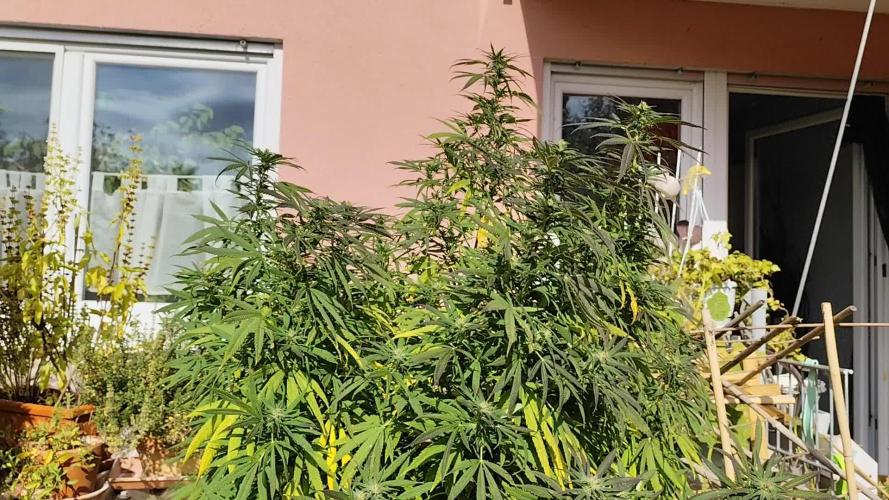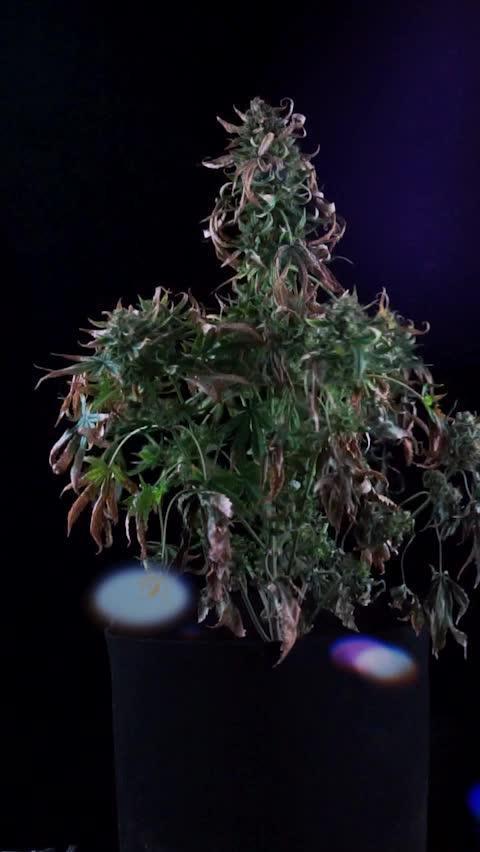The Grow Awards 2026 🏆 



























Likes
Comments
Share


@daggaDNA
Follow
6th week of 12/12 ended for my Big Block by Cannabis Brothers California.
Here I am exposing pheno number 8 this week as it's turning out great. I took it out on natural light and made few fotos so you can see it in more natural way. Besides having the nicest structure among 4 phenotypes, it's also developing the nicest flower structure and it looks like it will also finnish as first. Deffo a keeper in my eyes, but the final test will be smoking it, but we are still long way from there.
Other than that, video shows current situation in my 4x4 tent. Absolutely jaw dropping cultivar, growing in 6L pots but exceeding 1m in height and also it looks like a descent yielder. Not to mention the aroma intensity. It's just proving what I was hoping for - true OG bred by true OG's - the Cannabis Brothers.
Lineage
Blockberry x Motorbreath 15 (Legend OG)
Tap water feeding (Premium program)
Aptus
Light (BS600) + UVA/UVB 3hrs daily
@future_of_grow
Soil (lightmix) & pH
Plagron
Tent size
4x4 (120x120)
Pot size
6L (1.6 gal)
Stay tuned for few weeks more to see the final outcome, but pheno #8 is deffo the one I'm keeping. Peace out 💚
Likes
12
Share


@GREENPHOENIX6262
Follow
Fastbuds - Mimosa (2x) 08/27
Coming into week 4 Veg, User error stunted them lightly but things seem back on track.
Exhale 365 C02 bag introduced last week to setup for early flower.
No signs of concern or any deficiencies.
Early flowering has begun
*Mid-Week Update* *08/30*
Both plants have recovered nicely, and placed under trellis net.
Introduced NPK Phosphate
Purged Pure Blend Pro Grow
*End of week recap*
Flowering has begun
Stopped veg nute feed
Introduced Raw NPK Phosphorus and Potassium
Likes
12
Share


@DarbGrowDiaries
Follow
Could probably still go for another week, but as it was loosing so many leafs it was better for me to cut it early.
Buds are very dense so very interested to know the final weight
Processing
Likes
11
Share


@ganjaman24
Follow
Sorry guys been lagging on posting because got a lot other stuff going on n I figured this plant would’ve been chopped by now but I must say she’s been filling out quite nicely..I lowered the light hours to try n see if thatll he’ll ripen her a bit faster as I’m looking to replace her with another plant
Processing
Likes
41
Share


@JacareGrows
Follow
Hey guys.
For this week i upload some videos 1 video per plant.
I am not giving any more the bio nova autoflower supermix, i m thinking on let them going only with water until the end, but lets see.
Plant 5 is close to harvest i think on the end of this week.
Plant 1 and 4 are doing good on flowering.
Plant 2 is slowly flowering
Plant 3 is still in middle of the transition to flowering, is going very slow. I think she probably is blocked because of the size of the pot and light .
When i harvest plant 5 the others will have more space, and i can bend some branches to increase the bud quality.
The big question is, when harvest? its the first time im doing this and i am afraid of doing that wrong.
Hope the videos can help someone to help me :D
I have also made a video of plant 5 on a more close look, not to much quality but for now its what i can get , sorry
28/05 day 69
small trichome update of plant 3,4 and 5. Plant 1 and 2 still on pre flowering
analysing the trichomes, i would say,
Plant 3 and 4 need almost 2 more weeks
Plant 5 - probably only 1 week more, so up to almost week 12
plant 1 and 2 - will take much time as fotoperiodic LOL
Likes
12
Share


@Gorrilla420
Follow
Another good feed this week and took a few leaves off, both plants doing really well, drinking loads with the sun and size of them. Not much smell yet but plenty of time for that.
That’s all this week, happy growing 🌱
Likes
43
Share


@Growbody
Follow
Hallo und herzlich willkommen zu meinem Growbericht Outdoor 2025 mit den Sorten Power Flower Feminized, Royal Medic Feminized und Special Kush #1 Feminized, alle 3 von Royal Queen Seeds. Es ist das erste Mal, das ich Töpfe für den Outdoor grow verwende, bisher waren alle Gorilla grows und direkt in die Erde gepflanzt.
Die URL der Power Flower Feminized: https://www.royalqueenseeds.de/feminisierte-hanfsamen/120-power-flower.html
Die URL der Royal Medic Feminized: https://www.royalqueenseeds.de/cbd-samen/148-royal-medic.html
Die URL der Special Kush #1 Feminized: https://www.royalqueenseeds.de/feminisierte-hanfsamen/138-special-kush-1.html
Die Planung für den Grow ist, die Samen in easyplug Anzuchtwürfeln keimen zu lassen und danach in 0,6L und 2,2L Plastiktöpfen, dann letztlich in die neuen komplett doppellagigen ROOTIES 15 Liter Wide Version Stofftöpfe umzutopfen. Sobald die Witterung es zuläßt, sollen die Pflanzen an die frische Luft.
Es ist schon eine Weile her, das der Grow losging, die Bilder sind jetzt aktuell.
Tag 211: Für heute waren 20°C vorhergesagt, tatsächlich steckt die Sonne hinter dickem Hochnebel und es sind gerade mal 14°C. Heute Nacht geht's mit 2 °C Richtung Gefrierpunkt. Alle drei Ladies purpeln im Laub. Sie bekommen nur noch pures Brunnenwasser. Der abgebrochene Ast der Special Kush ist wieder komplett angewachsen.
Tag 215: Endlich mal wieder ein Sonnentag, Die Power Flower fem. hat sehr schöne Farben bekommen.
Tag 217: Auch heute hat es wieder bis nach Mittag gedauert, bis der Nebel weg war. In der Sonne kommen die Farben der drei Großen voll zur Geltung und die Trichome glitzern um die Wette.
Wenn's dir gefallen hat, schau wieder vorbei ✌️😎
Likes
8
Share


@dreamLife
Follow
Se ve super sana y con un buen tamaño para cambiar el ciclo lumínico a 12/12. Las raíces blancas y creciendo rápido.
Likes
9
Share


@CheeRz
Follow
It's week five of flowering, and Divine Rapier continues to do very well. The buds are developing nicely. Unfortunately, the weather is not so nice at the moment, with hardly any sunshine and lots of rain. The temperature is only 19°C during the day.
Likes
49
Share


@masterofsmeagol
Follow
6/23 Due To The Two 8 Day weeks this week will only consist of five days to get me back on track. SEE LAST WEEK FOR DETAILS. I DID ANOTHER EIGHT DAY WEEK. I'LL DO THIS WEEK AS SIX DAYS. THAT WAY IM BACK ON SCHEDULE. WATERED 6/22. WENT BACK AT NIGHTCAND WATERED ANOTHER GALLON WITH 1/3 TSP Armor Si. I mixed the solution with kelp you kelp me but I dumped it out. I've mixed silica with other nutes before but I had read something earlier about bioavailability issues and I didn't want to risk it. My plants are the healthiest I've ever grown. I'm considering transplanting the large 10th planet that I'm light depping. I also need to develop my ipm and my nute schedule. Still gonna have to keep an eye onvthe water situation. Luckily I have a buddy in my corner that's co tinualkt Bern a great help.
WENT BACK OVER AROUND NOON. BEAUTIFUL OUTSIDE AND THE PLANTS WERE LOVING THIS SUN. I DEFOLIATED SOME BURNED LEAVES AND MIXED A SOLUTION IF KELP ME KELP YOU THAT I PLAN TO FEED TO THE GARDEN TODAY. IM HAPPY WITH HOW THINGS ARE GOING. WE HAVE SOME RAIN AND THINDERSTORMS COMING. I NEED TO GET MY IPM UP AND RUNNING AND THE NUTES ONLINE. I ALSO NEED TO DECIDE IF IM GOING TO TRANSPLANT THE LIGHT DEP 10th PLANET. Went back over to put the girls to bed at six and if was still 90 degrees. The water from yesterday had dissipated. The tops were dust dry. I mixed two gallons of kelp you kelp me and fed it to the garden. Afterwards I pointed qbd found a couple plants that were more open to the wind were a little lighter. I know tomorrow will be very hot. Maybe quarter inch of rain. However after that it will rain (showers) off and on for days. I wanted to make sure the girls had what the needed to make it through tjis heat wave until they get that rain. I had another gallon mixed up and I'm thinking I should've given it to them. Oh well. I'd rather underwater than overwater any day. I did notice a burnt top on the plant furthest from the tarp that the sun JUST BARELY TOUCHES when the rest are in shade. I'll just raise the tarp a little. These are tiny problems. Can't upload video until tomorrow.
6/24 Good thing u gave the plants that water. I know it wasn't much but we didn't get any rain. Suppised to get a qtr in today and another qtr in tomorrow. Then rain a couple more days. It's working our really good for my watering schedule lol. Yesterday the girls got there first dose of a bottled nute. They got two gallons of kelp me kelp you (1/3 tsp per gallon) and another gallon of just phed water. I was going to do another gallon but held off due to the threat of syring rain. Didn't get it bur it looks like the plants loved the kelp. It had reached 90 yesterday. They look better today. It's 70 at 9 today. I LST the 10th planet in the 3 gallon. It's getting huge. I should start a separate diary for those three light dep plants. Its cool as hell watching this. One of the purple punches is flowering pretty good. I probably should start another diary for them. I'll be starting to feed my plants soon. Wondering if I should pinch plants again. TUCKED THE LITTLE GIRLS IN AT SIX AND SHOT A VIDEO AND TOOK SOME PUCTURES. PLANTS LOOKED PHENOMINAL! GOT HOME AND AROUND SEVEN IT JUST STARTED RORREBTIAL DOWNPOURS! THE TYPE OF RAIN THAT BREAKS STEMS. I SHOULDVE PUT MY OTHET TARP UP BUT I DIDNT. I WISH I HAD. IM A LITTLE NERVOUS. I KNOW THESE GIRLS ARE STRONG THOUGH! TOMORROW. ILL ROLL THE RARP UP AND SECURE THE BOTTOM FOR FAST ACCESS. IM ALSO GOING TO KOOK INTO FINDING A TOP FOR MY CAGE I CAN USE IN INCLIMENT WEATHER.
6/25 That little qtr in of rain we were supposed to get turned into torrential downpours and high winds. Luckily no REAL damage. If you watch the video you'll see what I mean. I'm going to havecto be cognizant moving forward. Noticed a few chunks from leaves butvplants are still healthy. I'm surprised how well these girls withstood this storm. They are certainly resilient. The 2 purple punch 1 10th planet that I'm light depping are flowering nicely now. They missed all the commotion from the storm as they were inside. It's smelling good. I'm happy.
6/26 It's what a friend would say is "maineing") out. That mistcthe plants love. I'm surprised the plants are doing as good as they have been considering the wind. Will be adding nutes soon. Need to add extra supports too. Light dep
6/27 Brief periods or torrential downpours. Light depped 3 gallon 0lants are under an overhanfcwhete the hatsxrain can't hurt them but they still get sun. They are really starting to flower now! I'm going to begin feeding with a base nute and a flower nute I think. I'm thinking about giving the light dep some open sesame or something similar. I need to set up a nute program soon but the plants ALL look so healthy! And it's been raining! I've only watered like once or twice since they've been in the big pots. I've seen zero pests aside from a chunk missing from a grasshopper. Usually by now I'd have battled half a dozen things and be battling another half dozen. However I was posing from clones. These are seeds and boy don't I see the difference!
Likes
24
Share


@The_Good_Twin
Follow
29 May 2021
I started the flowering stage yesterday, 5/28/21, and plan on defoliating and topping my Blue Ox baby today. I wanted to get any and all stressful alterations done before we got too far into flower to limit potential damage it can’t spring back from. The light is on a timer now, so from here on will be 12/12 schedule. I’m also adjusting the nutrients to flower, and starting this week at the “Transition to Flower” levels. I’m also starting to give a whole gallon of water for the first time as well. H2O was chilled to 41 degrees F, and contained: CALiMAGic 5ml, FloraMicro 7.5ml, FloraGro 7.5ml, and FloraBloom 7.5ml. The initial pH was 6.7, and didn’t require adjustment. The TDS going in was 807 ppm. Runoff pH was 6.2, and TDS runoff was 2103 ppm. The tent temp was 75 degrees F, and humidity was 50%. I practically stripped her naked today, and after finally getting a look at her branches will most likely do some LST in the coming days. I also took some cuttings to clear up space to control the grow better. I may try to clone them, but I haven’t decided yet.
31 May 2021
My Blue Ox is looking great! She adjusted to me practically taking all of her large leaves off without any issues. She looks so much better than she did before. I’m still using the “Transition to Flower” level nutrients with a gallon of chilled water (47.1 degrees F). I fed: CALiMAGic 5ml, FloraMicro 7.5ml, FloraGro 7.5ml, and FloraBloom 7.5ml. The initial pH was good at 6.8, and TDS going in was 924 ppm. The pH runoff was 6.2, and TDS runoff was 2400 ppm. Tent temp was 79 degrees F, and humidity was 44%.
Likes
2
Share


@knicko
Follow
ende von Woche 2 wurden sie in ihren finalen topf gegeben da sie bald in die Blüte geschickt werden
Likes
Comments
Share


@Card1Cultivations
Follow
March 24 - 30
Pretty mellow week with final prep for leaving them unattended for 5 days.
Drizzela is showing signs of a lime green discoloration in a small area to keep an eye on.
Blumat is steady and dialed in. The plan will be to water over the Blumat system with recharge mixed in which will prolong calling for water from the reservoir.
Likes
93
Share


@Roberts
Follow
Auto Opium has been making progress since her rough start. She got lst early in the week and some more today. She is looking really good this week. She is due for a solution change soon. Thank you Medic Grow, and Divine Seeds. 🤜🏻🤛🏻🌱🌱🌱
Thank you grow diaries community for the 👇likes👇, follows, comments, and subscriptions on my YouTube channel👇. ❄️🌱🍻
Happy Growing 🌱🌱🌱
https://youtube.com/channel/UCAhN7yRzWLpcaRHhMIQ7X4g



























